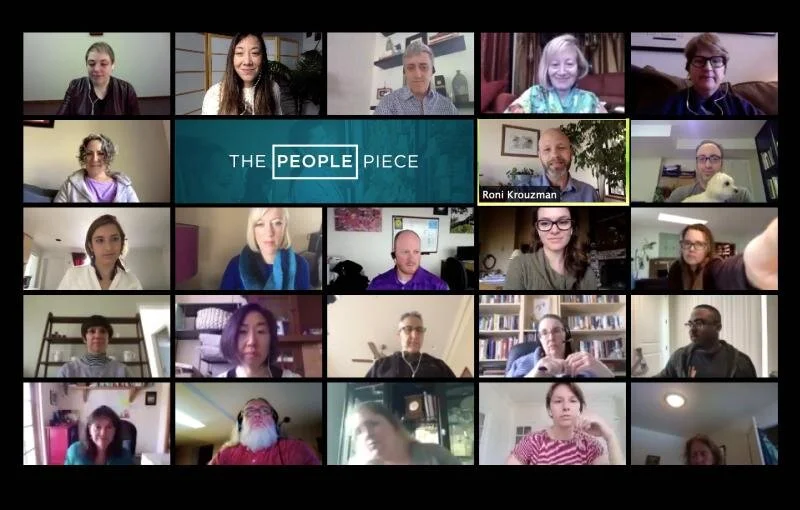Keeping Training Human in a Virtual World
6 key principles for designing and leading engaging,
human-centered people development programs and off-sites.
“Next, we’re going to explore how important curiosity is as you develop a growth mindset,” you hear the facilitator explain.
He doesn’t sound as excited as he did when the training began at 9am. And now, with lunch approaching and the slide count at 46 of 62, you’ve shut off your video and are sneaking a few emails in the background.
It can be challenging enough to keep people development programs engaging when they are facilitated in person. It’s even harder when those people can’t be in the same room.
We’ve seen a lot of organizations struggle to translate their people and team development programs into a virtual setting. Some efforts have floundered and others have simply been tabled until things ‘return to normal.’
Yet by now, most organizations have realized that ‘normal’ times, if there ever was such a thing, aren’t coming back any time soon. Remote learning will be the way of the future: while in-person gatherings will return and play an essential role, virtual development will play an increasingly significant role in development efforts, if only to save time, energy and money.
During this challenging and uncertain transitional time, many leaders, managers and teams know they need to continue to develop the mindsets, skillsets and practices that will enable them to produce, collaborate and innovate today and into the future.
So how do we keep training and team development human and engaging in a virtual world? How do we ensure interaction, relevance and agility when we don’t have access to the usual cues facilitators depend on?
Before the pandemic hit, around half of the leadership and team development programs we design and facilitate at The People Piece were conducted virtually with teams across the US, Canada, Europe and Asia. When in-person experiences ground to a halt, we were forced to quickly adapt all of our work to a virtual setting, including more in-depth training and facilitations.
Our philosophy has always been human-first, and there’s no exception in our virtual sessions. Thankfully, we were able to leverage our own experience, learn from others, and invent on the fly to ensure an interactive, human-centered approach prevailed in a virtual setting.
To be honest, we’ve been surprised by just how effective virtual development can be, including the more in-depth leadership training and team offsites we are now conducting remotely. Here are 6 ways we engage and motivate individuals and groups in a virtual setting:
Relevant Design Matters More Than Ever
There are thousands of models, tools, and formulas anyone can use when designing a training or group development experience. But regardless of how effective, well researched, or tried and true any of these are, content will only truly resonate when it feels relevant to the needs, challenges, and desires of individuals, teams, and organizations, especially in a virtual environment. Here’s how we design programs that fit:
Understand the group. Take the time up front to understand the needs of the group you’ll be working with.
Engage human-centered design. Design with real people in mind.
Gather and incorporate feedback. Gauge impact and refine as you go (see Leave Space to Adapt section).
The art and science of designing relevant and engaging training and group experiences is rich and complex. Contact us if you’d like to learn more about our action-oriented, human-centered approach.
Icebreakers Over Zoom?
When it comes to virtual training and experience design, icebreakers are often overlooked. But don’t underestimate the value of getting people to warm up to the facilitators and to each other, especially in a virtual environment.
Start early in the session. The sooner the group begins to ‘break the ice,’ the sooner people will show up authentically and ready to contribute and learn.
Design relevant icebreakers. Define the objective and design the icebreakers appropriate to your audience and its goals.
Keep it intelligent. Keep your icebreakers geared toward the complexity of your learners.
Leverage Technology to Drive Engagement
Technology, of course, plays a key role in fostering and maintaining virtual engagement. Here are some of the best ways to leverage the functionality of Zoom, as well as another of our favorite tools, Mural:
Zoom - the video conference tool is likely familiar to most by now, but not everyone takes advantage of its full functionality.
The chat function is an easy way to keep sessions interactive without spending precious minutes on verbal shares that might go off the rails.
Breakout rooms encourage engagement and participation in larger groups.
Polls are a quick and easy way to test knowledge retention, gauge the sentiment of a group, and solicit on-the-spot feedback.
Mural - is like an interactive white board and slide presentation rolled into one. It allows groups to learn, contribute and collaborate remotely. We leverage Mural in each of our virtual sessions, enabling learners to see and work with models and frameworks, problem solve and share ideas in the form of virtual sticky notes, and even use a voting function to prioritize objectives. We recommend you give it a try.
Keep Those Cameras On
We ask participants in our sessions to be present via video the entire time if possible. There are the obvious reasons - people are usually more distracted when they aren’t on video - and there are some important additional benefits as well:
Humans want to connect. Seeing all of the other people in the group helps session participants to connect not just with each other - which is beneficial for building and maintaining team cohesion - but also with the content being taught.
Snap a group photo at the end of a session or training series. We share these photos with participants and also keep them on file in case we work with the same participants again and want to be reminded of the spirit and personalities of the group.
Engage Global Listening
Since engagement rests on relevance, virtual trainers are hampered by fewer cues that point to whether our content and approach are landing or not. Thankfully, we all have an awareness superpower, a tool we reviewed in last month’s blog called ‘Global’ or ‘Level 3’ listening. Global Listening allows facilitators to read between the lines and respond accordingly. This enables us to understand when a Zoom-fatigued group may need a break (and how long of a break), what content is landing and when it may be necessary to pivot, and even, which unspeakable ‘elephants’ a group may need to address to progress. Check out our recent blog on the Levels of Listening to explore this topic in more depth.
Leave Space to Adapt
On a final note, perhaps even more than in-person, training designers and facilitators must leave space for adaptation during virtual experiences. You may be 3 hours into a session when your global listening tells you something is off. Perhaps you notice that participation levels have slipped and start to notice people’s eyes glazing over. It’s time to ditch the agenda and figure out what the group needs in order to re-engage. Follow your intuition to adjust on the fly and give the group what it needs. You can also design options in your agendas, and sometimes, ask the group what it needs during the actual session.
2020 has reminded us that human beings have a remarkable ability to adapt. Training and facilitation may be more difficult in a virtual world, but they are not impossible to execute effectively.
Humans have an innate desire to connect and learn, and we can provide those experiences by following core, human-centered design and facilitation principles, and leveraging technology in new and creative ways.
Feel free to share this article with friends and colleagues if you find it useful, and contact us if you’d like to learn how our webinars, coaching, training, and facilitated experiences help employees, managers, leaders and teams innovate, communicate and collaborate more effectively.
Roni Krouzman is Founder and CEO of The People Piece, a people and team development firm that customizes trainings, strategies and digital solutions for growing, values-based companies. Mikayla Posk supports the organization’s team and organization development programs. People Piece virtual training maven Marina Tavares also contributed key concepts to this piece.










Check out our favorite People Piece blogs, videos, and toolkits from a year like no other. They all highlight what is core to our philosophy - human first: at work, in leadership, and in life.